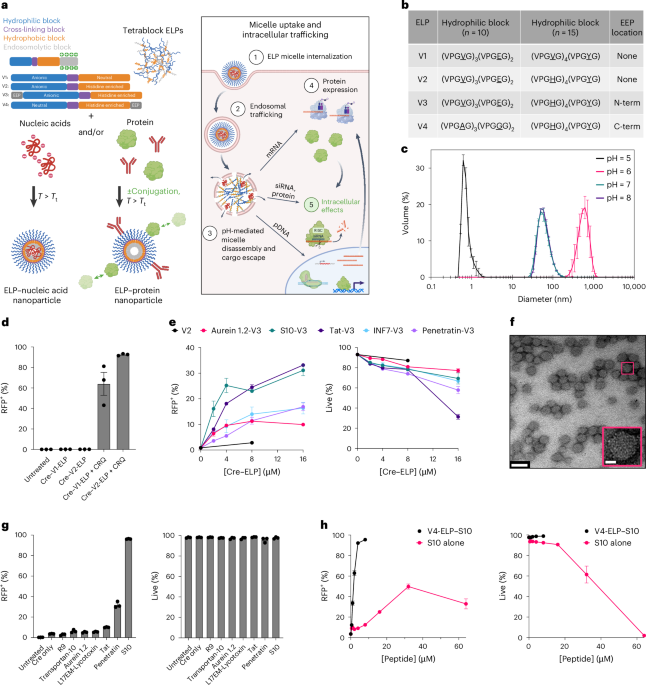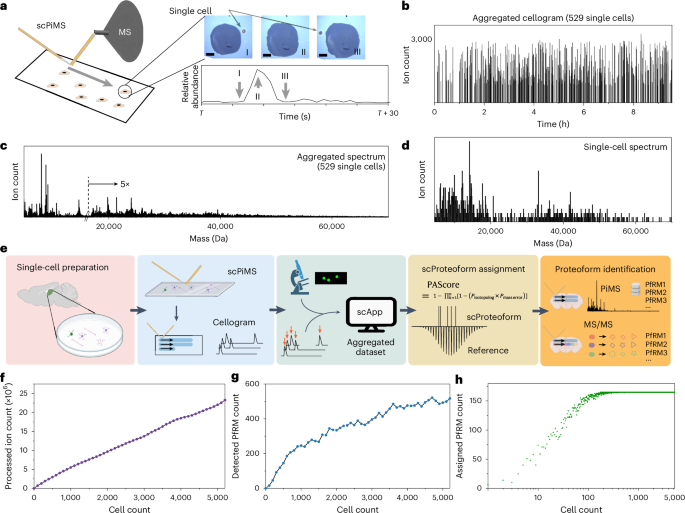Now Reading: Self-assembling protein nanoparticles for cytosolic delivery of nucleic acids and proteins
-
01
Self-assembling protein nanoparticles for cytosolic delivery of nucleic acids and proteins
Self-assembling protein nanoparticles for cytosolic delivery of nucleic acids and proteins

Baden, L. R. et al. Efficacy and safety of the mRNA-1273 SARS-CoV-2 vaccine. N. Engl. J. Med. 384, 403–416 (2021).
Polack, F. P. et al. Safety and efficacy of the BNT162b2 mRNA COVID-19 vaccine. N. Engl. J. Med. 383, 2603–2615 (2020).
Adams, D. et al. Patisiran, an RNAi therapeutic, for hereditary transthyretin amyloidosis. N. Engl. J. Med. 379, 11–21 (2018).
Gillmore, J. D. et al. CRISPR–Cas9 in vivo gene editing for transthyretin amyloidosis. N. Engl. J. Med. 385, 493–502 (2021).
Frangoul, H. et al. CRISPR–Cas9 gene editing for sickle cell disease and β-thalassemia. N. Engl. J. Med. 384, 252–260 (2021).
Ramaswamy, S. et al. Systemic delivery of factor IX messenger RNA for protein replacement therapy. Proc. Natl Acad. Sci. USA 114, E1941–E1950 (2017).
Rurik, J. G. et al. CAR T cells produced in vivo to treat cardiac injury. Science 375, 91–96 (2022).
Parayath, N. N., Stephan, S. B., Koehne, A. L., Nelson, P. S. & Stephan, M. T. In vitro-transcribed antigen receptor mRNA nanocarriers for transient expression in circulating T cells in vivo. Nat. Commun. 11, 6080 (2020).
Mendes, B. B. et al. Nanodelivery of nucleic acids. Nat. Rev. Methods Primers 2, 24 (2022).
Tian, Y., Tirrell, M. V. & LaBelle, J. L. Harnessing the therapeutic potential of biomacromolecules through intracellular delivery of nucleic acids, peptides, and proteins. Adv. Healthc. Mater. 11, 2102600 (2022).
Bulcha, J. T., Wang, Y., Ma, H., Tai, P. W. L. & Gao, G. Viral vector platforms within the gene therapy landscape. Sig. Transduct. Target. Ther. 6, 53 (2021).
Zhao, Z., Anselmo, A. C. & Mitragotri, S. Viral vector‐based gene therapies in the clinic. Bioeng. Transl. Med. 7, e10258 (2021).
Hou, X., Zaks, T., Langer, R. & Dong, Y. Lipid nanoparticles for mRNA delivery. Nat. Rev. Mater. 6, 1078–1094 (2021).
Das, R., Kanjilal, P., Medeiros, J. & Thayumanavan, S. What’s next after lipid nanoparticles? A perspective on enablers of nucleic acid therapeutics. Bioconjug. Chem. 33, 1996–2007 (2022).
Koren, E., Apte, A., Sawant, R. R., Grunwald, J. & Torchilin, V. P. Cell-penetrating TAT peptide in drug delivery systems: proteolytic stability requirements. Drug Deliv. 18, 377–384 (2011).
Schmidt, N., Mishra, A., Lai, G. H. & Wong, G. C. L. Arginine-rich cell-penetrating peptides. FEBS Lett. 584, 1806–1813 (2010).
Derossi, D., Joliot, A. H., Chassaing, G. & Prochiantz, A. The third helix of the Antennapedia homeodomain translocates through biological membranes. J. Biol. Chem. 269, 10444–10450 (1994).
Krishnamurthy, S. et al. Engineered amphiphilic peptides enable delivery of proteins and CRISPR-associated nucleases to airway epithelia. Nat. Commun. 10, 4906 (2019).
Sánchez-Navarro, M. Advances in peptide-mediated cytosolic delivery of proteins. Adv. Drug Deliv. Rev. 171, 187–198 (2021).
Boisguérin, P., Konate, K., Josse, E., Vivès, E. & Deshayes, S. Peptide-based nanoparticles for therapeutic nucleic acid delivery. Biomedicines 9, 583 (2021).
Kim, W. & Chaikof, E. L. Recombinant elastin-mimetic biomaterials: emerging applications in medicine. Adv. Drug Deliv. Rev. 62, 1468–1478 (2010).
Gagner, J. E., Kim, W. & Chaikof, E. L. Designing protein-based biomaterials for medical applications. Acta Biomater. 10, 1542–1557 (2014).
Jenkins, I. C., Milligan, J. J. & Chilkoti, A. Genetically encoded elastin-like polypeptides for drug delivery. Adv. Healthc. Mater. 10, 2100209 (2021).
Urry, D. W. Physical chemistry of biological free energy transduction as demonstrated by elastic protein-based polymers. J. Phys. Chem. B 101, 11007–11028 (1997).
Dreher, M. R. et al. Temperature triggered self-assembly of polypeptides into multivalent spherical micelles. J. Am. Chem. Soc. 130, 687–694 (2008).
Li, N. K., García Quiroz, F., Hall, C. K., Chilkoti, A. & Yingling, Y. G. Molecular description of the LCST behavior of an elastin-like polypeptide. Biomacromolecules 15, 3522–3530 (2014).
Kim, W., Xiao, J. & Chaikof, E. L. Recombinant amphiphilic protein micelles for drug delivery. Langmuir 27, 14329–14334 (2011).
Kim, W., Brady, C. & Chaikof, E. L. Amphiphilic protein micelles for targeted in vivo imaging. Acta Biomater. 8, 2476–2482 (2012).
Kim, W. et al. Targeted antithrombotic protein micelles. Angew. Chem. Int. Ed. Engl. 54, 1461–1465 (2015).
Yi, A., Sim, D., Lee, Y.-J., Sarangthem, V. & Park, R.-W. Development of elastin-like polypeptide for targeted specific gene delivery in vivo. J. Nanobiotechnology 18, 15 (2020).
Yi, A., Sim, D., Lee, S.-B., Sarangthem, V. & Park, R.-W. Application of bioengineered elastin-like polypeptide-based system for targeted gene delivery in tumor cells. Biomater. Biosyst. 6, 100050 (2022).
Eweje, F. et al. Protein-based nanoparticles for therapeutic nucleic acid delivery. Biomaterials 305, 122464 (2024).
Kim, W., Thévenot, J., Ibarboure, E., Lecommandoux, S. & Chaikof, E. L. Self-assembly of thermally responsive amphiphilic diblock copolypeptides into spherical micellar nanoparticles. Angew. Chem. Int. Ed. Engl. 49, 4257–4260 (2010).
Zuris, J. A. et al. Cationic lipid-mediated delivery of proteins enables efficient protein-based genome editing in vitro and in vivo. Nat. Biotechnol. 33, 73–80 (2015).
Dorr, B. M., Ham, H. O., An, C., Chaikof, E. L. & Liu, D. R. Reprogramming the specificity of sortase enzymes. Proc. Natl Acad. Sci. USA 111, 13343–13348 (2014).
Kwon, H.-S. et al. Anti-human CD117 antibody-mediated bone marrow niche clearance in nonhuman primates and humanized NSG mice. Blood 133, 2104–2108 (2019).
Czechowicz, A. et al. Selective hematopoietic stem cell ablation using CD117-antibody-drug-conjugates enables safe and effective transplantation with immunity preservation. Nat. Commun. 10, 617 (2019).
Freeman, E. C., Weiland, L. M. & Meng, W. S. Modeling the proton sponge hypothesis: examining proton sponge effectiveness for enhancing intracellular gene delivery through multiscale modeling. J. Biomater. Sci. Polym. Ed. 24, 398–416 (2013).
Hajimolaali, M. et al. Application of chloroquine as an endosomal escape enhancing agent: new frontiers for an old drug. Expert Opin. Drug Deliv. 18, 877–889 (2021).
Nielsen, E. J. B. et al. In vivo proof of concept of oral insulin delivery based on a co-administration strategy with the cell-penetrating peptide penetratin. J. Control. Release 189, 19–24 (2014).
El-Sayed, A., Masuda, T., Khalil, I., Akita, H. & Harashima, H. Enhanced gene expression by a novel stearylated INF7 peptide derivative through fusion independent endosomal escape. J. Control. Release 138, 160–167 (2009).
Rai, D. K. & Qian, S. Interaction of the antimicrobial peptide aurein 1.2 and charged lipid bilayer. Sci. Rep. 7, 3719 (2017).
Peterson, J. J. & Meares, C. F. Cathepsin substrates as cleavable peptide linkers in bioconjugates, selected from a fluorescence quench combinatorial library. Bioconjug. Chem. 9, 618–626 (1998).
Biniossek, M. L., Nägler, D. K., Becker-Pauly, C. & Schilling, O. Proteomic identification of protease cleavage sites characterizes prime and non-prime specificity of cysteine cathepsins B, L, and S. J. Proteome Res. 10, 5363–5373 (2011).
Abboud-Jarrous, G. et al. Cathepsin L is responsible for processing and activation of proheparanase through multiple cleavages of a linker segment. J. Biol. Chem. 283, 18167–18176 (2008).
Biswas, A. et al. Endoprotease-mediated intracellular protein delivery using nanocapsules. ACS Nano 5, 1385–1394 (2011).
Xie, J. et al. Cell-penetrating peptides in diagnosis and treatment of human diseases: from preclinical research to clinical application. Front. Pharmacol. 11, 697 (2020).
Guterstam, P. et al. Elucidating cell-penetrating peptide mechanisms of action for membrane interaction, cellular uptake, and translocation utilizing the hydrophobic counter-anion pyrenebutyrate. Biochim. Biophys. Acta 1788, 2509–2517 (2009).
Islam, M. Z., Ariyama, H., Alam, J. M. & Yamazaki, M. Entry of cell-penetrating peptide transportan 10 into a single vesicle by translocating across lipid membrane and its induced pores. Biochemistry 53, 386–396 (2014).
Akishiba, M. et al. Cytosolic antibody delivery by lipid-sensitive endosomolytic peptide. Nat. Chem. 9, 751–761 (2017).
Sato, H. & Feix, J. B. Peptide–membrane interactions and mechanisms of membrane destruction by amphipathic α-helical antimicrobial peptides. Biochim. Biophys. Acta 1758, 1245–1256 (2006).
Ho, A., Schwarze, S. R., Mermelstein, S. J., Waksman, G. & Dowdy, S. F. Synthetic protein transduction domains: enhanced transduction potential in vitro and in vivo. Cancer Res. 61, 474–477 (2001).
Kabelka, I. & Vácha, R. Advances in molecular understanding of α-helical membrane-active peptides. Acc. Chem. Res. 54, 2196–2204 (2021).
Brock, D. J. et al. Mechanism of cell penetration by permeabilization of late endosomes: interplay between a multivalent TAT peptide and bis(monoacylglycero)phosphate. Cell Chem. Biol. 27, 1296–1307 (2020).
Guay, D., Del’Guidice, T. & Lepetit-Stoffaes, J.-P. Polypeptide-based shuttle agents for improving the transduction efficiency of polypeptide cargos to the cytosol of target eukaryotic cells, uses thereof, methods and kits relating to same. US patent US9738687B2 (2016).
Wang, G., Li, X. & Wang, Z. APD3: the antimicrobial peptide database as a tool for research and education. Nucleic Acids Res. 44, D1087–D1093 (2016).
Pirtskhalava, M. et al. DBAASP v3: database of antimicrobial/cytotoxic activity and structure of peptides as a resource for development of new therapeutics. Nucleic Acids Res. 49, D288–D297 (2021).
Tsai, C.-Y. et al. Helical structure motifs made searchable for functional peptide design. Nat. Commun. 13, 102 (2022).
Machida, S., Niimi, S., Shi, X., Ando, Y. & Yu, Y. Design of a novel membrane-destabilizing peptide selectively acting on acidic liposomes. Biosci. Biotechnol. Biochem. 64, 985–994 (2000).
Slaninová, J. et al. Toxicity study of antimicrobial peptides from wild bee venom and their analogs toward mammalian normal and cancer cells. Peptides 33, 18–26 (2012).
Oh, J. H. et al. Multimeric amphipathic α-helical sequences for rapid and efficient intracellular protein transport at nanomolar concentrations. Adv. Sci. 5, 1800240 (2018).
Chong, S.-E. et al. Intracellular delivery of immunoglobulin G at nanomolar concentrations with domain Z-fused multimeric α-helical cell penetrating peptides. J. Control. Release 330, 161–172 (2021).
Kobayashi, T. et al. Separation and characterization of late endosomal membrane domains. J. Biol. Chem. 277, 32157–32164 (2002).
Zhang, S., Shen, J., Li, D. & Cheng, Y. Strategies in the delivery of Cas9 ribonucleoprotein for CRISPR/Cas9 genome editing. Theranostics 11, 614–648 (2021).
Rilo-Alvarez, H., Ledo, A. M., Vidal, A. & Garcia-Fuentes, M. Delivery of transcription factors as modulators of cell differentiation. Drug Deliv. Transl. Res. 11, 426–444 (2021).
Zhang, F. et al. Genetic programming of macrophages to perform anti-tumor functions using targeted mRNA nanocarriers. Nat. Commun. 10, 3974 (2019).
Krausgruber, T. et al. IRF5 promotes inflammatory macrophage polarization and TH1–TH17 responses. Nat. Immunol. 12, 231–238 (2011).
Rennick, J. J., Johnston, A. P. R. & Parton, R. G. Key principles and methods for studying the endocytosis of biological and nanoparticle therapeutics. Nat. Nanotechnol. 16, 266–276 (2021).
Hołubowicz, R. et al. Safer and efficient base editing and prime editing via ribonucleoproteins delivered through optimized lipid-nanoparticle formulations. Nat. Biomed. Eng. 9, 57–78 (2025).
Chen, K. et al. Lung and liver editing by lipid nanoparticle delivery of a stable CRISPR–Cas9 ribonucleoprotein. Nat. Biotechnol. https://doi.org/10.1038/s41587-024-02437-3 (2024).
Mónica Bravo-Anaya, L. et al. Coupling of RAFT polymerization and chemoselective post-modifications of elastin-like polypeptides for the synthesis of gene delivery hybrid vectors. Polym. Chem. 12, 226–241 (2021).
Bravo-Anaya, L. M. et al. Nucleic acids complexation with cationic elastin-like polypeptides: stoichiometry and stability of nano-assemblies. J. Colloid Interface Sci. 557, 777–792 (2019).
Kelly, G. et al. Intratumoral delivery of brachytherapy and immunotherapy by a thermally triggered polypeptide depot. J. Control. Release 343, 267–276 (2022).
Lee, C. H., Ingrole, R. S. J. & Gill, H. S. Generation of induced pluripotent stem cells using elastin like polypeptides as a non-viral gene delivery system. Biochim. Biophys. Acta Mol. Basis Dis. 1866, 165405 (2020).
Piña, M. J. et al. A double safety lock tumor-specific device for suicide gene therapy in breast cancer. Cancer Lett. 470, 43–53 (2020).
Del’Guidice, T. et al. Membrane permeabilizing amphiphilic peptide delivers recombinant transcription factor and CRISPR–Cas9/Cpf1 ribonucleoproteins in hard-to-modify cells. PLoS ONE 13, e0195558 (2018).
Chow, D. C., Dreher, M. R., Trabbic-Carlson, K. & Chilkoti, A. Ultra-high expression of a thermally responsive recombinant fusion protein in E. coli. Biotechnol. Prog. 22, 638–646 (2006).
Tripathi, N. K. Production and purification of recombinant proteins from Escherichia coli. ChemBioEng Rev. 3, 116–133 (2016).
Schneier, M., Razdan, S., Miller, A. M., Briceno, M. E. & Barua, S. Current technologies to endotoxin detection and removal for biopharmaceutical purification. Biotechnol. Bioeng. 117, 2588–2609 (2020).
Zhang, S., Sun, Y., Zhang, L., Zhang, F. & Gao, W. Thermoresponsive polypeptide fused l-asparaginase with mitigated immunogenicity and enhanced efficacy in treating hematologic malignancies. Adv. Sci. 10, 2300469 (2023).
Cheng, T.-F. et al. Differential activation of IFN regulatory factor (IRF)-3 and IRF-5 transcription factors during viral infection. J. Immunol. 176, 7462–7470 (2006).
Brinkman, E. K., Chen, T., Amendola, M. & van Steensel, B. Easy quantitative assessment of genome editing by sequence trace decomposition. Nucleic Acids Res. 42, e168 (2014).
Xu, L., Liu, Y. & Han, R. BEAT: a Python program to quantify base editing from Sanger sequencing. CRISPR J. 2, 223–229 (2019).
Seluanov, A., Vaidya, A. & Gorbunova, V. Establishing primary adult fibroblast cultures from rodents. J. Vis. Exp. 2010, 2033 (2010).
Angsana, J. et al. Syndecan-1 modulates the motility and resolution responses of macrophages. Arterioscler. Thromb. Vasc. Biol. 35, 332–340 (2015).
Chen, J. et al. Modulation of lymphocyte-mediated tissue repair by rational design of heterocyclic aryl hydrocarbon receptor agonists. Sci. Adv. 6, eaay8230 (2020).
Tran, N. T. et al. Efficient CRISPR/Cas9-mediated gene knockin in mouse hematopoietic stem and progenitor cells. Cell Rep. 28, 3510–3522 (2019).
Bayes, H. K., Ritchie, N., Irvine, S. & Evans, T. J. A murine model of early Pseudomonas aeruginosa lung disease with transition to chronic infection. Sci. Rep. 6, 35838 (2016).
Eweje, F. et al. Self-assembling protein nanoparticles for cytosolic delivery of nucleic acids and proteins. GitHub https://github.com/sayoeweje/elp-eep-discovery (2025).






















